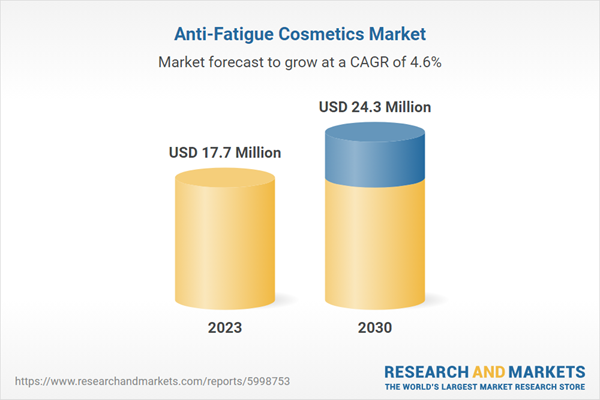Anti-Fatigue Cosmetics Market Growth & Trends
The global anti-fatigue cosmetics market size is expected to reach USD 24.3 million by 2030, registering a CAGR of 4.6% from 2024 to 2030. Growing stress, hectic lifestyle, and unhealthy diet of people around the world have been having a negative impact on their skin, thereby driving the demand for anti-fatigue cosmetics. An increasing number of skincare awareness campaigns by leading cosmetics brands is also likely to expand the scope of various anti-fatigue cosmetics.Creams held the largest revenue share of over 37.3% in 2023, with overnight moisturizers, under-eye creams, and under-eye primers emerging as the most popular products in this category. These products hydrate the skin and reduce dullness, puffiness, dark circles, and pores. Numerous companies have been introducing effective anti-fatigue cosmetics with innovative ingredients to stay ahead of the competition. For instance, Glamglow launched its Brighteyes Illuminating Anti-Fatigue Eye Cream in 2019, aimed at energizing the entire eye area and making it appear well-rested. The fast-absorbing cream nourishes tired-looking under eyes with ingredients such as apple, watermelon, and narcissus extracts, caffeine, linoleic acid, and peptides.
The online distribution channel is projected to expand at the fastest CAGR of 5.4% over the forecast period owing to the thriving e-commerce industry and growing consumer preference for purchasing cosmetics and personal care products online. Sephora, Amazon, Ulta Beauty, Inc., Feelunique, and Strawberrynet are some of the key e-retailers of anti-fatigue and other cosmetics. Asia Pacific is expected to witness a steady CAGR of 5.2% from 2024 to 2030. Consumers in countries like China, Japan, South Korea, and India have shown a high interest in personal care. This awareness, coupled with increasing purchasing power, will impact the demand for anti-fatigue cosmetics.
Key competitors in this market include L’Oréal S.A.; Unilever; Shiseido Company, Limited; The Estée Lauder Companies Inc.; Bio Veda Action Research Co. (Biotique); Christian Dior SE; Nuxe, Inc.; Mesoestetic; Groupe Clarins SA; and The Ordinary. Companies have been expanding their business by extending production capacity or through merger and acquisition activities. For instance, in June 2016, Bio Veda Action Research Co. (Biotique) announced its plan to invest USD 27.9 million in manufacturing capacity expansion. Similarly, in November 2016, The Estée Lauder Companies Inc. acquired BECCA Cosmetics. This acquisition helped the former expand its makeup portfolio, with a focus on offering more complexion and color products.
Anti-Fatigue Cosmetics Market Report Highlights
- Creams held the largest revenue share of over 37.3% in 2023, with overnight moisturizers, under-eye creams, and under-eye primers emerging as the most popular products in this category
- The Asia Pacific anti-fatigue cosmetics market is anticipated to witness significant growth
- North America dominated the anti-fatigue cosmetics market in 2023, accounting for 36.5% of the global revenue share. This can be attributed to the increased prevalence of skin fatigue among consumers in the U.S. and Canada
- The online distribution channel is projected to expand at the fastest CAGR of 5.4% over the forecast period owing to the thriving e-commerce industry and growing consumer preference for purchasing cosmetics and personal care products online
Why should you buy this report?
- Comprehensive Market Analysis: Gain detailed insights into the global market across major regions and segments.
- Competitive Landscape: Explore the market presence of key players worldwide.
- Future Trends: Discover the pivotal trends and drivers shaping the future of the global market.
- Actionable Recommendations: Utilize insights to uncover new revenue streams and guide strategic business decisions.
This report addresses:
- Market intelligence to enable effective decision-making
- Market estimates and forecasts from 2018 to 2030
- Growth opportunities and trend analyses
- Segment and regional revenue forecasts for market assessment
- Competition strategy and market share analysis
- Product innovation listing for you to stay ahead of the curve
- COVID-19's impact and how to sustain in these fast-evolving markets
This product will be delivered within 1-3 business days.
Table of Contents
Chapter 1. Methodology and Scope
Chapter 2. Executive Summary
Chapter 3. Anti-Fatigue Cosmetics Market Variables, Trends, & Scope
Chapter 4. Anti-Fatigue Cosmetics Market: Product Estimates & Trend Analysis
Chapter 5. Anti-Fatigue Cosmetics Market: End Use Estimates & Trend Analysis
Chapter 6. Anti-Fatigue Cosmetics Market: Distribution Channel Estimates & Trend Analysis
Chapter 7. Anti-Fatigue Cosmetics Market: Regional Estimates & Trend Analysis
Chapter 8. Competitive Landscape
Companies Mentioned
- L'Oréal Paris
- Unilever
- Shiseido Company, Limited
- The Estée Lauder Companies Inc.
- Bio Veda Action Research Co. (Biotique)
- Christian Dior SE
- Nuxe
- Groupe Clarins
- DECIEM Beauty Group Inc.
Methodology

LOADING...
Table Information
| Report Attribute | Details |
|---|---|
| No. of Pages | 120 |
| Published | August 2024 |
| Forecast Period | 2023 - 2030 |
| Estimated Market Value ( USD | $ 17.7 Million |
| Forecasted Market Value ( USD | $ 24.3 Million |
| Compound Annual Growth Rate | 4.6% |
| Regions Covered | Global |
| No. of Companies Mentioned | 9 |









